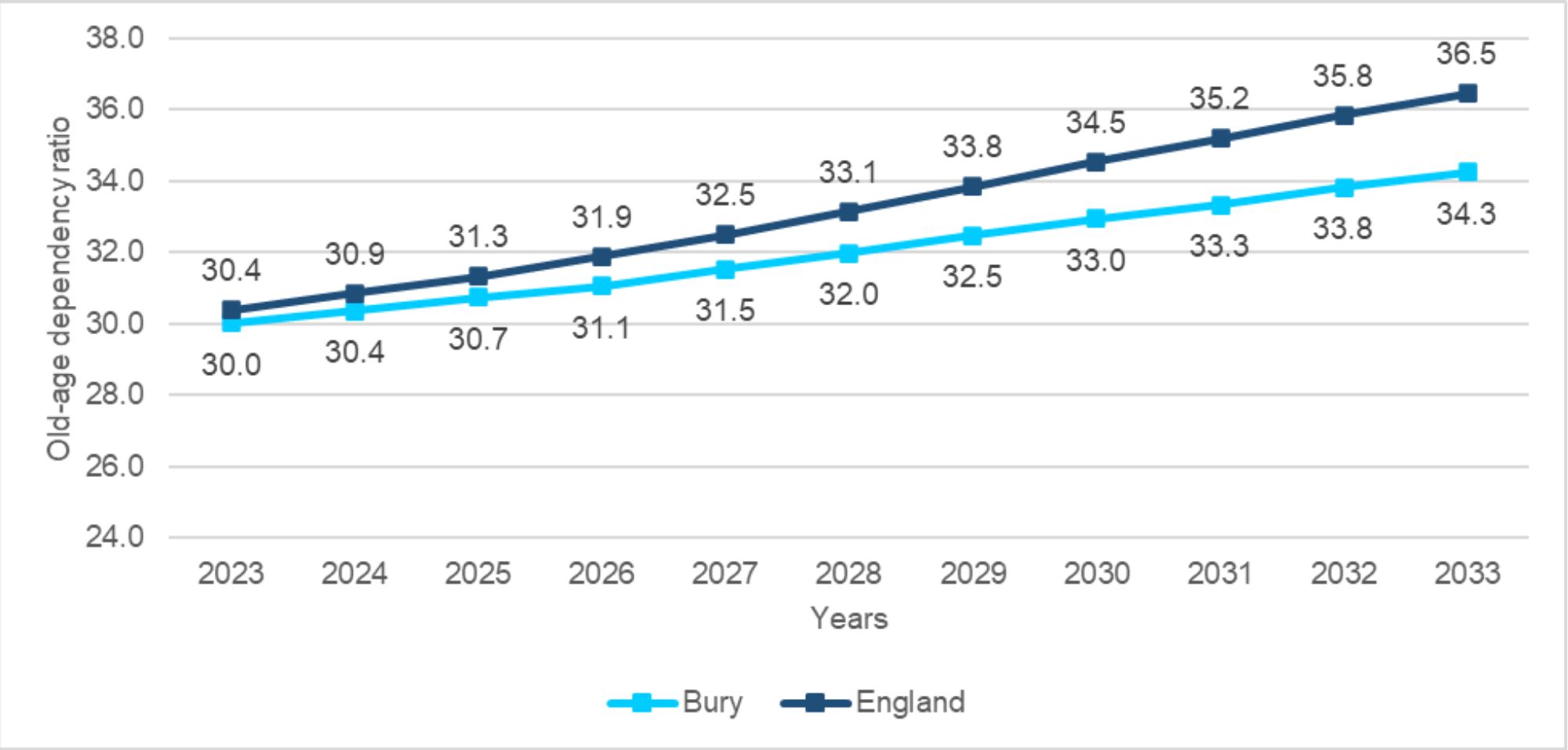
Population Projections
Population projection provides an estimate of the future size and age structure of a population. They are based on population estimates and assumptions about birth rates, death rates, and migration. Projections are available for local authorities in England and are published every two years, with the most recent based on mid-2018 population estimates. Projections are given forwards 25 years at the local authority levels and forwards 100 years at England level, but they become less reliable the further into the future the projection is made.
Population projection is important for several reasons. It can help local stakeholders and planners to anticipate future demographic changes and plan accordingly. For example, projections can help local governments to predict future health needs, plan for housing and make decisions about infrastructure investments. Population projection is also important for researchers and demographers to study trends in the population and their impact on society. Projections provide a framework for analysing the potential social, economic, and political implications of future demographic changes, including changes in age structure, labour force participation, and migration patterns.
When interpreting the population projections, it is important to exercise caution and consider a range of factors that may impact them. A few examples of these factors encompass:
- Assumptions: Forecasts are based on assumptions concerning future migration, fertility, and deaths in a population. This can make precise predictions difficult, and it is important to consider limitations of the projections when interpreting data.
- Accuracy: The accuracy of population projections depends on data quality. Historical data, while informative, may contain inaccuracies or biases that can skew results. Therefore, it is important to evaluate the standard of input used for these estimates and recognise any potential constraints they pose towards achieving accurate forecasts.
- Uncertainty: The range of possible outcomes, for population projections is uncertain and cannot be precisely predicted. Multiple factors like new government policies, advancements in technology or unexpected occurrences such as pandemics or natural disasters can cause this uncertainty to persist within the data collected during these predictions.
- Variations at the local level: Projections of population are commonly derived from national or regional statistics and may not account for differences in a specific area. It is crucial to consider variables that could potentially influence demographic patterns, like economic stability, shifts in societal norms, as well as attitudes towards cultural values unique to a local community.
- Limitations of the model: The constraints of the framework are such that population expectations derive from mathematical models with certain weaknesses. Specifically, specific models may neglect to precisely gauge how social or economic modifications affect trends in a population.
As population projections become less reliable the further away they are made. We will examine projections for Bury until the year 2023.
Between the year 2023 and 2033 there will be a projected increase of almost 5,798 people living in Bury (Figure 1).
Figure 1: Population projections for all ages in Bury from 2023 to 2033
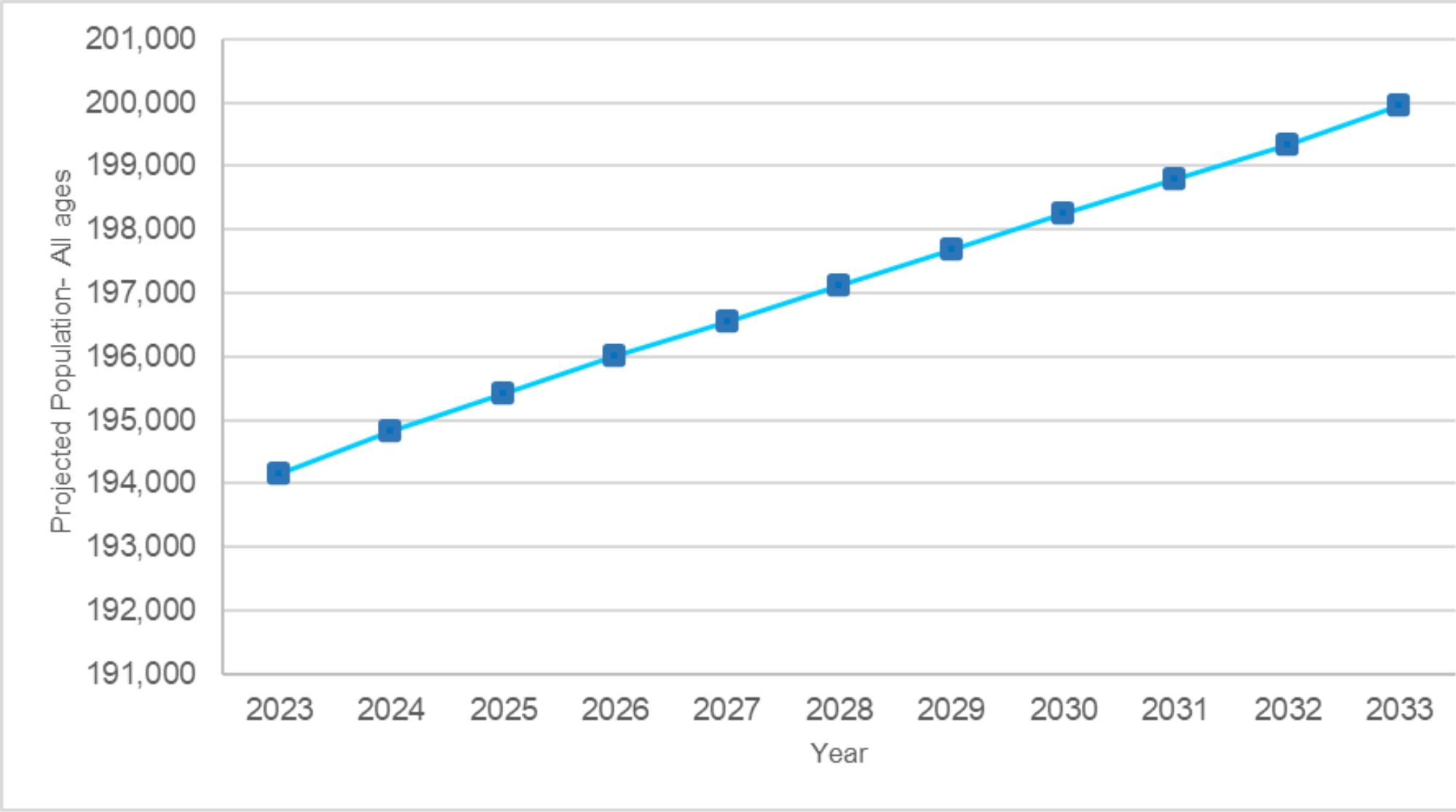
However, this change is not expected to be uniform across all age groups. The next section examines how different age groups (such as the population of babies and infants, children, young people, those of working age, and those over the age of 65) are expected to change over the next few years.
Babies & infants (0-4 years of age)
Between the years 2023 and 2033, the number of babies and infants are projected to increase by 404 (3.6%). In the same time period, England is projected to experience a 0.1% decrease in babies and infants aged 0-4 years.
Figure 2: Population projections for babies and infants aged 0-4 year in Bury from 2023 to 2033
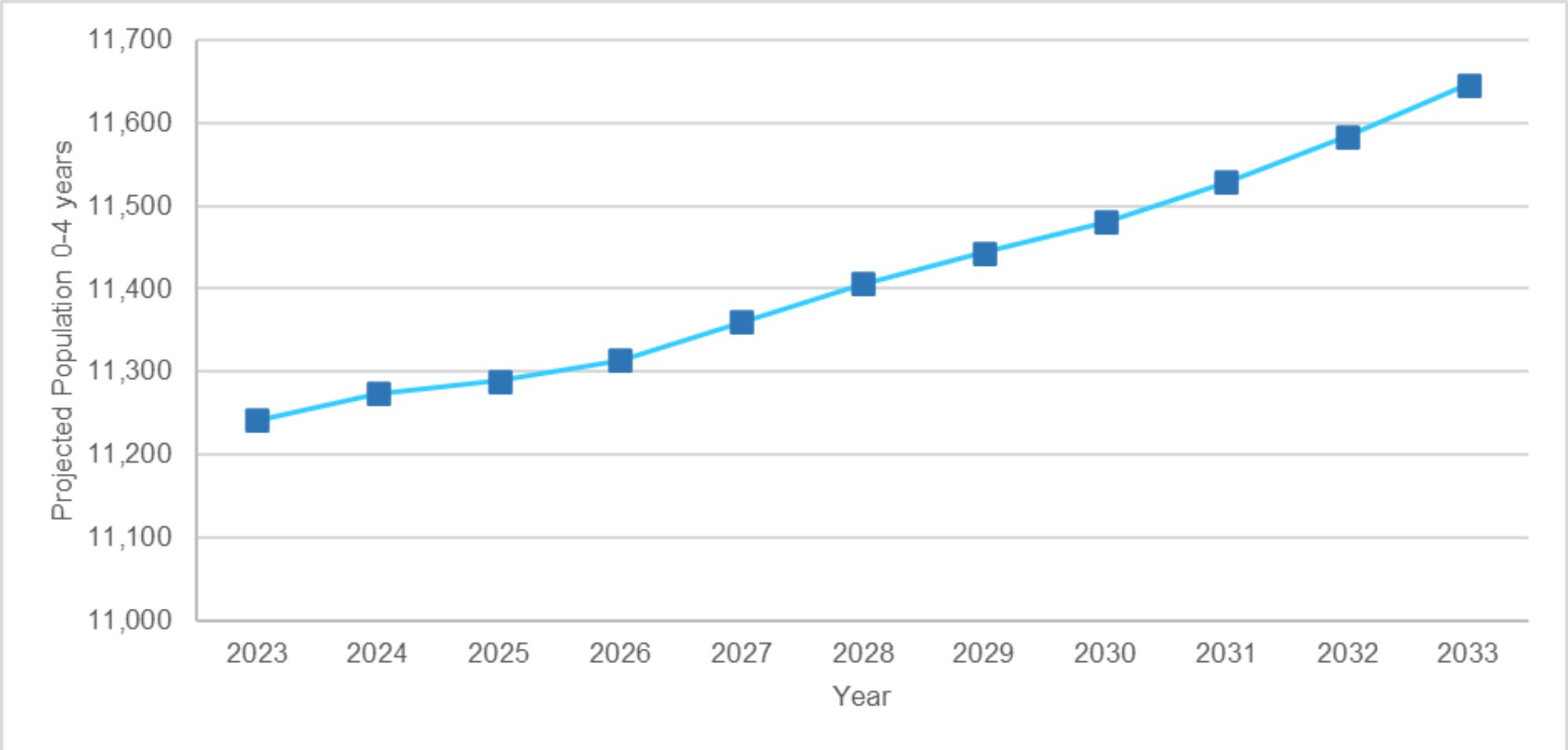
Children (5-11 years of age)
Children aged 5-11 years are projected to decrease by 1117 (6.3%) in Bury between the years 2023 and 2033. This is lower than the 8.6% decrease projected for England in the same time period.
Figure 3: Population projections for children aged 5-11 years in Bury from 2023 to 2033
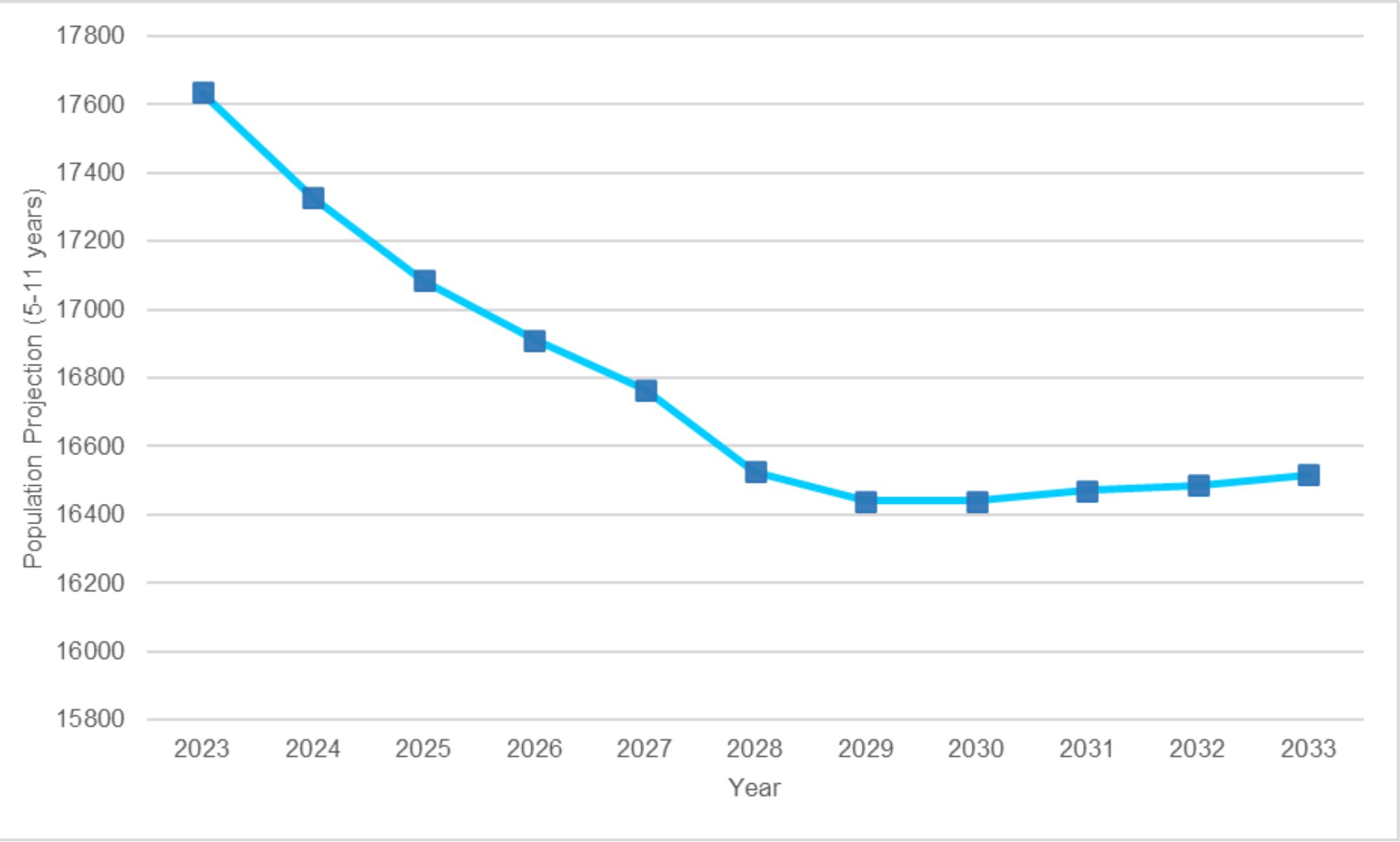
Young People (12-17 years)
Young people number in Bury is expected to decrease by 440 (2.9%) during the years 2023 to 2033. A similar decrease is seen in England by 2.3 during this time period.
Figure 4: Population projections for children aged 5-11 years in Bury from 2023 to 2033
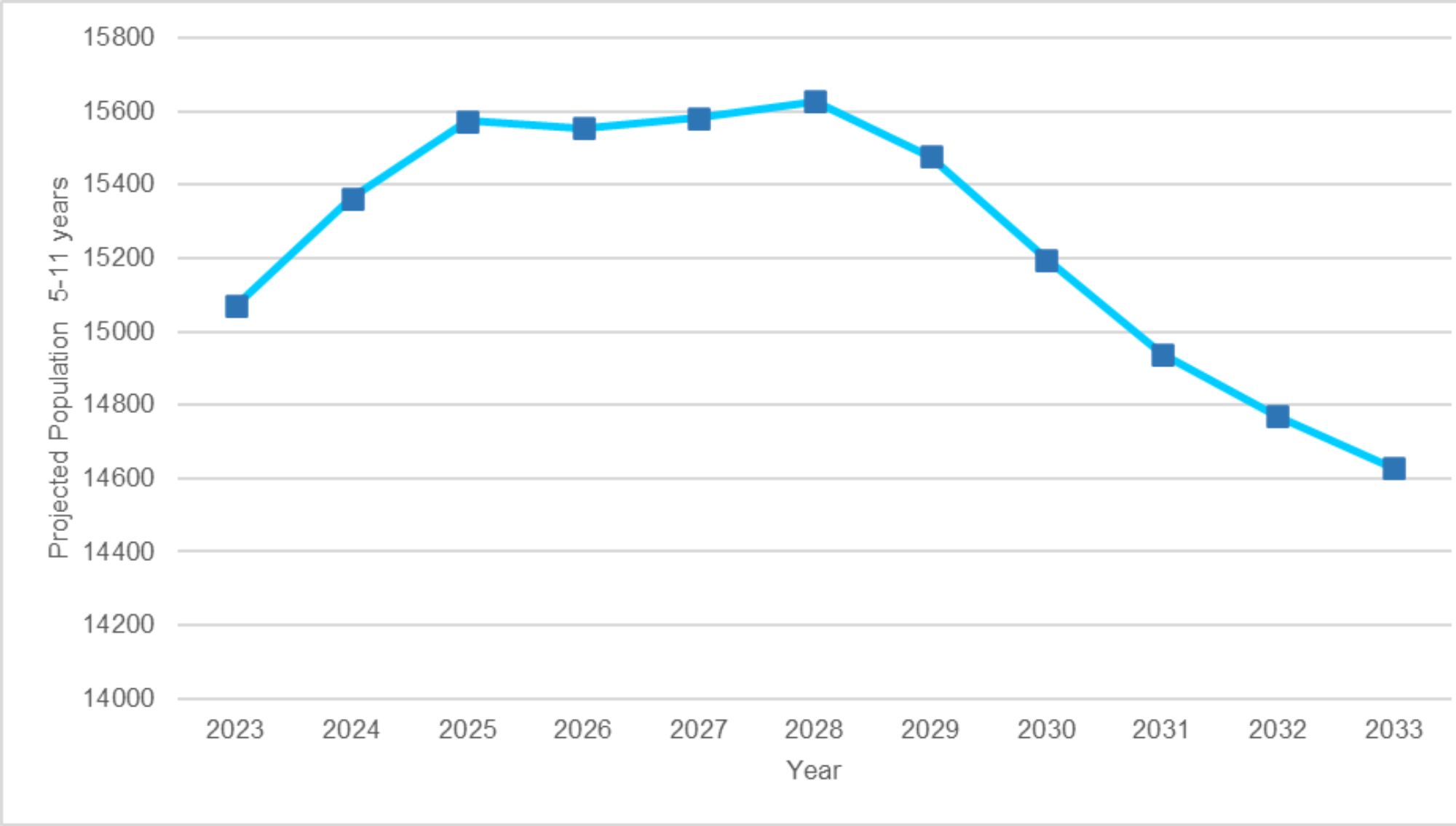
Working age adults (18-64 years)
The working age population of Bury is projected to increase by 1333 people by 2033. This is an increase of 1.2% similar to the increase of 1.1% projected for England between 2023 to 2033.
Figure 5: Population projections for working age adults 18-64 years in Bury from 2023 to 2033
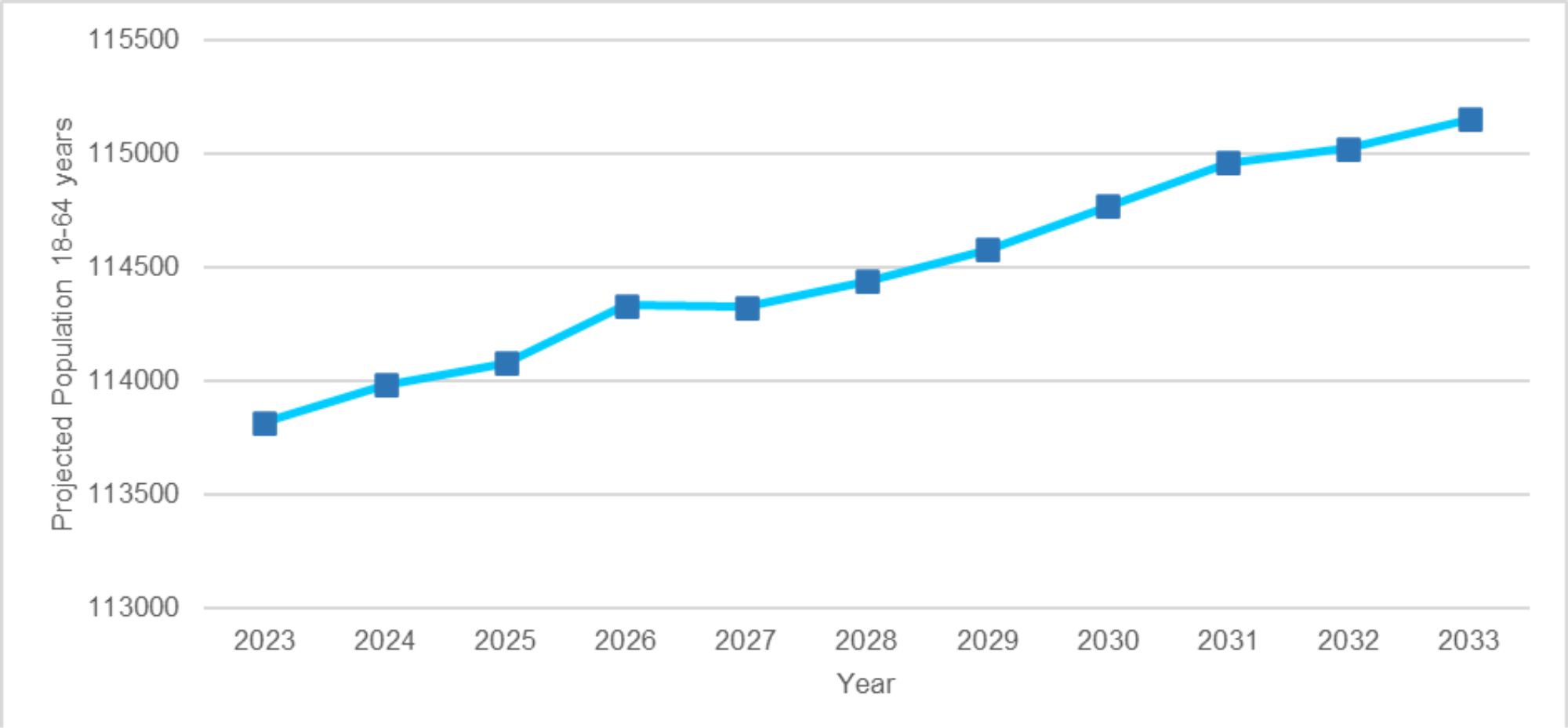
Older adults (65 years and over)
Older adults in Bury are expected to see the biggest increase of 15.4% with an additional 5,617 older adults between the years 2023 to 2033. During the same time period, England is expected to see an even greater increase of 21.4% in older adults.
Figure 6: Population projections for older adults 65 years and over in Bury from 2023 to 2033
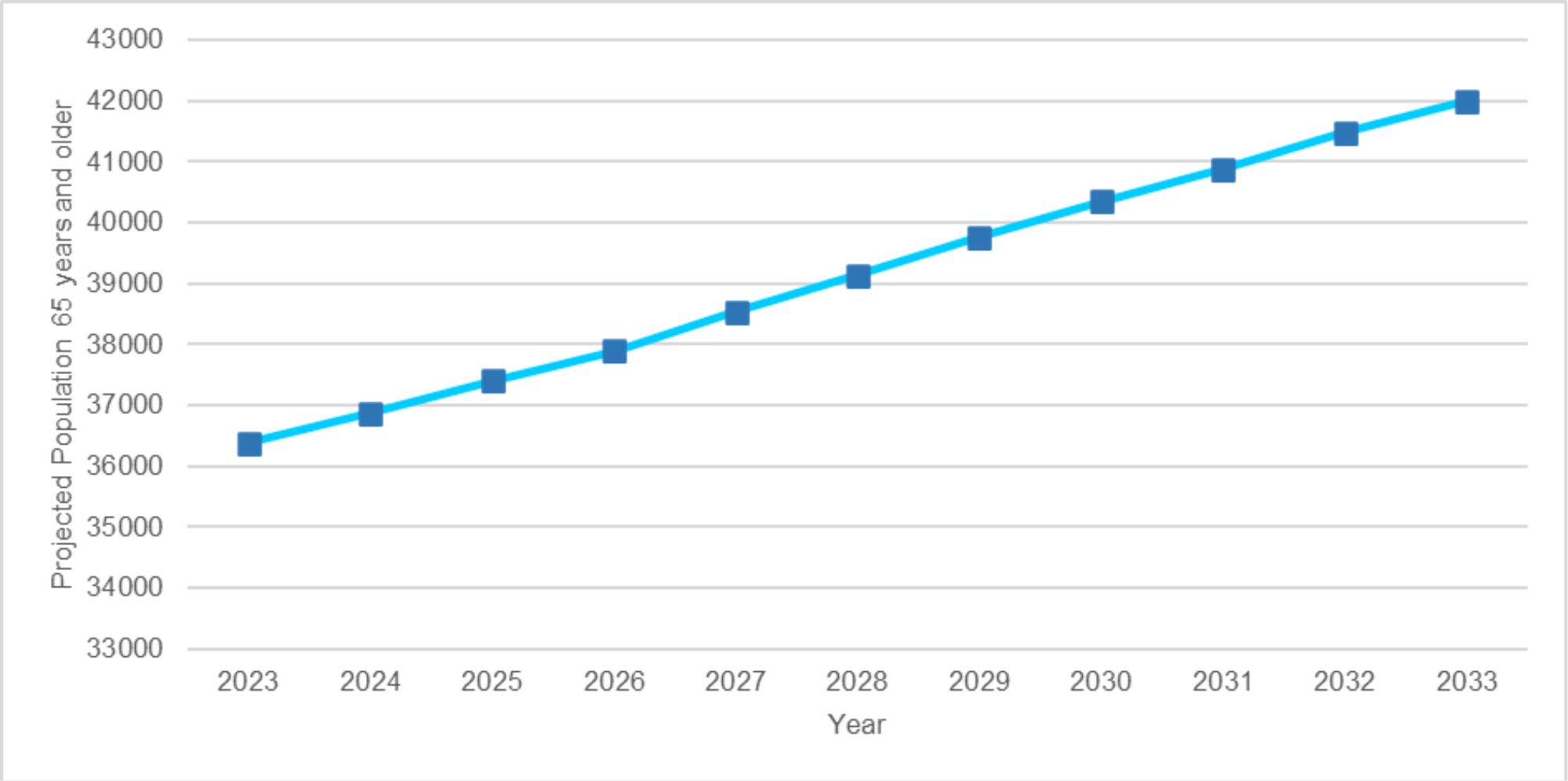
Despite the predicted increase in older adults population lower than that predicted for England, this still represents a significant shift in the demographic composition of Bury.
Dependency ratios
Dependency ratio is a measure used in demography and public health to understand the age structure of a population and how much non-working individuals depend on those who do work for support. The higher the ratio, the greater the pressure on the working age adults.
There are three main types of dependency ratios
- Total dependency ratio: This measure is the ratio of the total number of dependents (both too young and old to work) to the number of working-age individuals in the population. It provides a broader understanding of the extent to which non-working individuals depend on those who are working for support.
- Youth dependency ratio: This is the ratio of the number of children aged 0-14 to the number of people aged 15-64 in the population. It provides an indication of the number of children who are dependent on working-age individuals.
- Old-age dependency ratio: This is the ratio of the number of people aged 65 and over to the number of people aged 15-64 in the population. It provides an indication of the number of older age adults who are dependent on working-age individuals.
Dependency ratios should be interpreted with caution due to a number of limitations:
- It does not consider the potential for people to work beyond traditional retirement ages. With the aging population and improved health, older people are working for longer, which can skew the results.
- The measure assumes that all dependents are economically inactive and rely on the working-age population for support. However, this is not always the case, as many young people work part-time or engage in other activities that contribute to the economy.
- The measure also assumes that all working-age individuals are employed and financially supporting dependents. However, not all working-age individuals are employed or financially stable and can be economically inactive due to long term illness, disability or stay at home parent.
Total dependency ratio
Based on the projected population based on ONS mid-2018 estimates, Bury and England are both projected to experience an increase in total dependency ratio from 2023 to 2033. Throughout this period, Bury’s total dependency ratio is consistently higher than England. The total dependency ratio in Bury is projected to increase from 60.2 to 63.1 in the year 2033. A ratio of 63.1 means that for every 100 population of working age (15-64 years), there are 63 people (under 15 or over 65 years) who are dependent on them. Similarly, total dependency ratio in England is also expected to rise from 58.4 to 62.6 (Figure 7).
Figure 7: Total dependency ratio for Bury and England from 2023 to 2033 based on ONS mid-2018 population estimates.
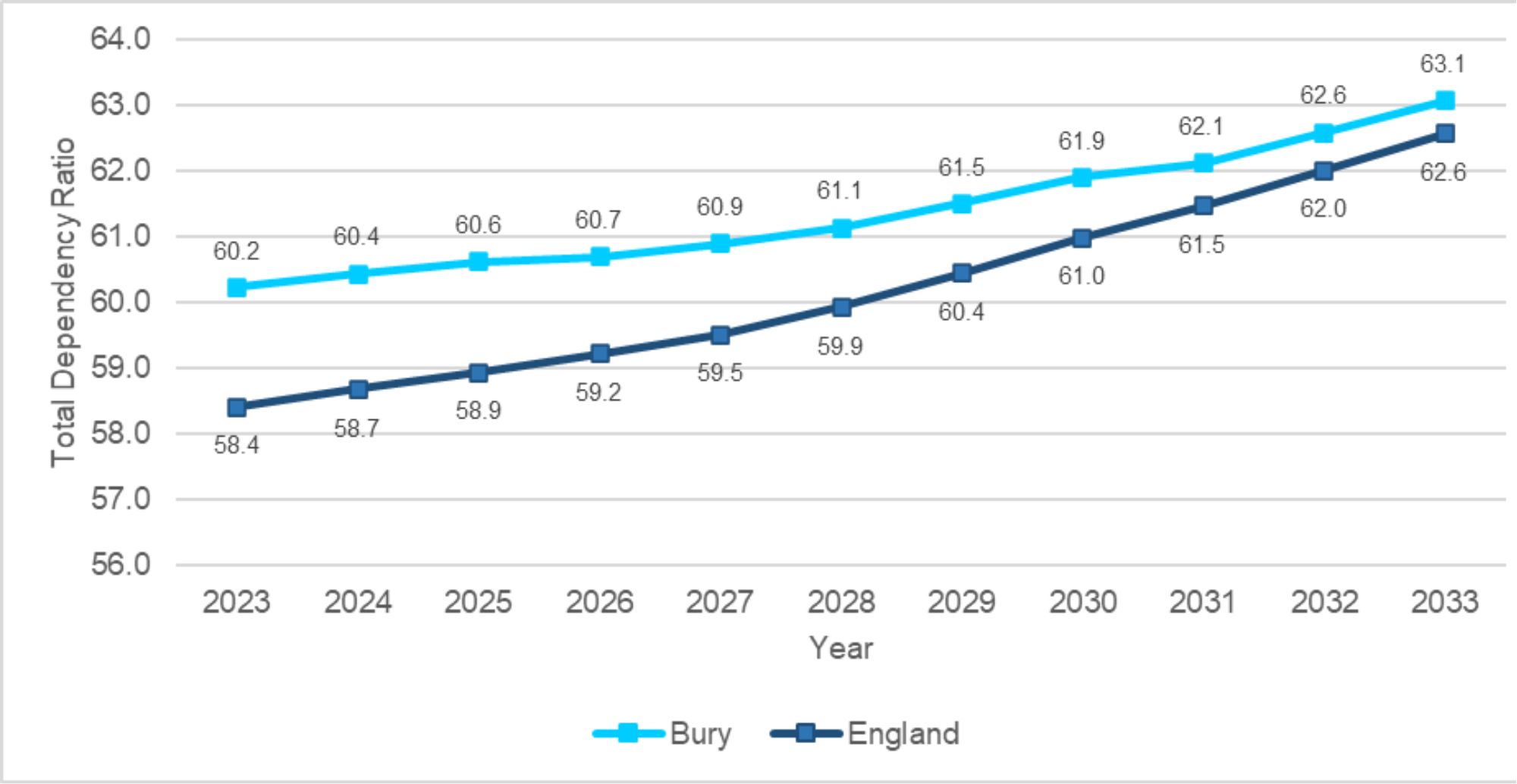
Youth dependency ratio
Bury and England are both projected to experience decrease in youth dependency ratio from 2023 to 2033. This means that there will be fewer individuals under the age of 15 who are dependent on the working age population for support. However, youth dependency ratio in Bury is expected to remain higher than England throughout 2023 to 2033. Bury's youth dependency ratio is projected to be 30.2 in 2023, compared to England's youth dependency ratio of 28.0. This trend is expected to continue throughout the period, with Bury's youth dependency ratio decreasing to 28.8 in 2033, compared to England's youth dependency ratio of 26.1 (Figure 8). The higher youth dependency ratio in Bury compared to England suggests that Bury may have a greater burden of providing care and support for children and young people who are dependent on others.
Figure 8: Youth dependency ratio for Bury and England from 2023 to 2033 based on ONS mid-2018 population estimates.
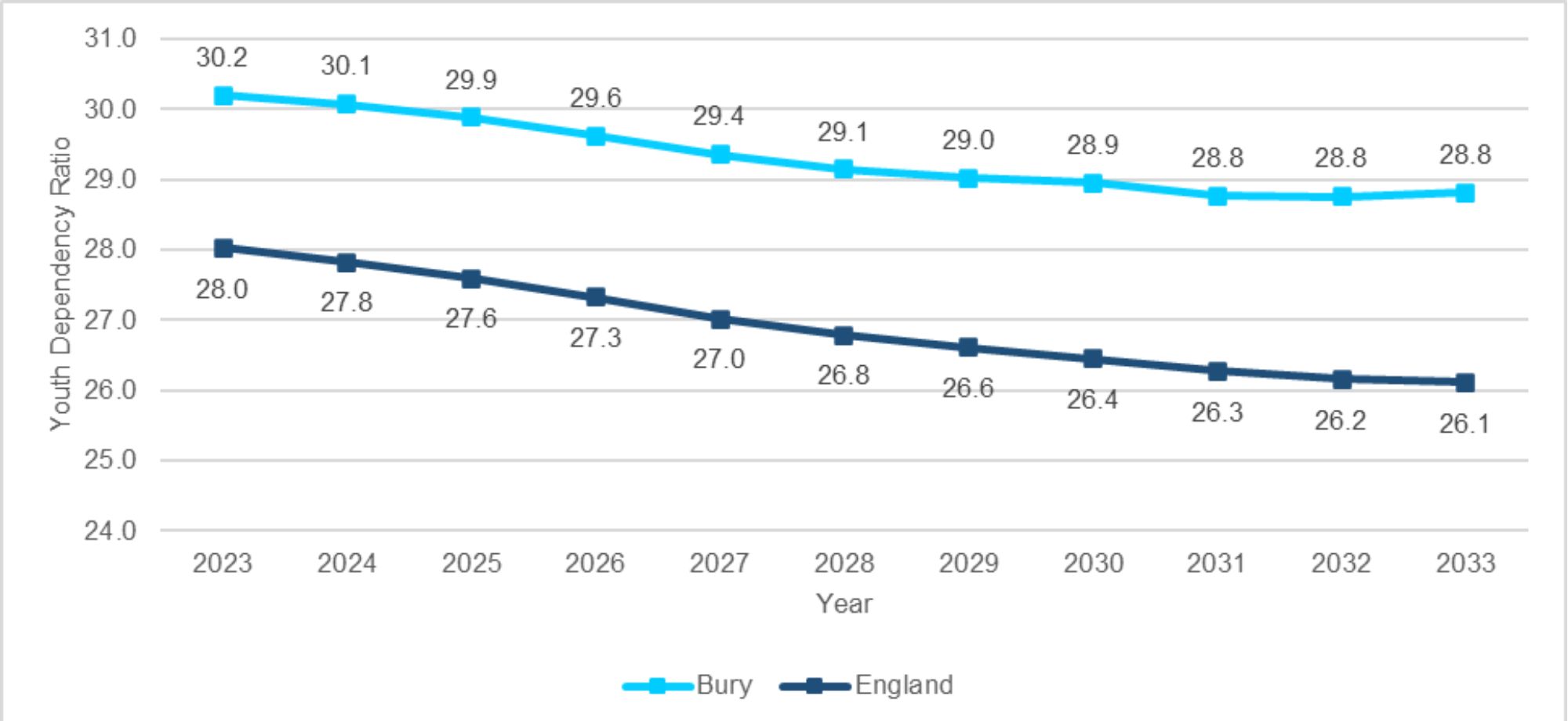
Old-age dependency ratio
Figure 9 below shows that Bury and England are both projected to experience an increase in old-age dependency ratio from 2023 to 2033. The ratio in Bury is predicted to remain below England’s average throughout this time period. In 2023, the old age dependency ratio in Bury is projected to be 30.0 compared to 30.4 in England. This difference continues until 2033, with Bury's old-age dependency ratio increasing to 34.3, compared to England's old-age dependency ratio of 36.5.
Figure 9: Old-age dependency ratio for Bury and England from 2023 to 2033 based on ONS mid-2018 population estimates.
